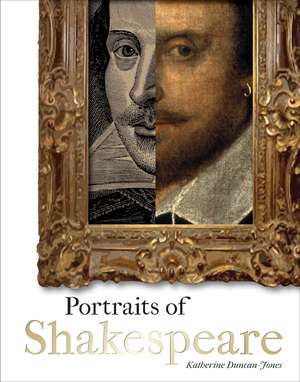Portraits of Shakespeare
Autor Katherine Duncan-Jonesen Limba Engleză Paperback – 24 sep 2015
Most of us can recall with clarity a favorite scene from Shakespeare. But call to mind the playwright’s appearance and there are many depictions to choose from with few widely accepted. Shakespeare himself left no description of his appearance nor can any evidence be found that he commissioned a portrait.
With Portraits of Shakespeare, Katherine Duncan-Jones poses a series of questions about the mysterious physical appearance of the brilliant writer of plays, poems, and sonnets: Why is it so difficult to find images of Shakespeare that were made during his lifetime? Which images are most likely to have been made by those close to the writer? And why do newly discovered images emerge with such startling regularity? With an eye toward answering these questions, the book begins with a broad analysis of the tradition of the “author portrait” before, during, and after Shakespeare’s lifetime. Duncan-Jones provides a detailed critique of three of the most widely accepted portraits: the engraving facing the First Folio’s title page; the sculptured stone bust that adorns Shakespeare’s funerary monument at Holy Trinity Church, Stratford-upon-Avon; and the “Chandos portrait,” an early seventeenth-century painting on canvas which is widely recognized as the best image. Through a painstaking historical analysis of the painting’s early history and provenance, Duncan-Jones arrives at a plausible new identification of both the artist and the artist’s personal connections with Shakespeare. Finally, taking the book into the present, she considers the afterlife of all three images in memorials, advertising, and in graphic art—all evidence of a continuing desire to put a face to one of literature’s most famous names.
With Portraits of Shakespeare, Katherine Duncan-Jones poses a series of questions about the mysterious physical appearance of the brilliant writer of plays, poems, and sonnets: Why is it so difficult to find images of Shakespeare that were made during his lifetime? Which images are most likely to have been made by those close to the writer? And why do newly discovered images emerge with such startling regularity? With an eye toward answering these questions, the book begins with a broad analysis of the tradition of the “author portrait” before, during, and after Shakespeare’s lifetime. Duncan-Jones provides a detailed critique of three of the most widely accepted portraits: the engraving facing the First Folio’s title page; the sculptured stone bust that adorns Shakespeare’s funerary monument at Holy Trinity Church, Stratford-upon-Avon; and the “Chandos portrait,” an early seventeenth-century painting on canvas which is widely recognized as the best image. Through a painstaking historical analysis of the painting’s early history and provenance, Duncan-Jones arrives at a plausible new identification of both the artist and the artist’s personal connections with Shakespeare. Finally, taking the book into the present, she considers the afterlife of all three images in memorials, advertising, and in graphic art—all evidence of a continuing desire to put a face to one of literature’s most famous names.
Preț: 103.03 lei
Nou
Puncte Express: 155
Preț estimativ în valută:
19.71€ • 21.48$ • 16.61£
19.71€ • 21.48$ • 16.61£
Carte indisponibilă temporar
Doresc să fiu notificat când acest titlu va fi disponibil:
Se trimite...
Preluare comenzi: 021 569.72.76
Specificații
ISBN-13: 9781851244058
ISBN-10: 1851244050
Pagini: 128
Ilustrații: 40 color plates
Dimensiuni: 171 x 222 x 15 mm
Greutate: 0.45 kg
Editura: Bodleian Library, University of Oxford
Colecția Bodleian Library, University of Oxford
ISBN-10: 1851244050
Pagini: 128
Ilustrații: 40 color plates
Dimensiuni: 171 x 222 x 15 mm
Greutate: 0.45 kg
Editura: Bodleian Library, University of Oxford
Colecția Bodleian Library, University of Oxford
Notă biografică
Katherine Duncan-Jones is an emeritus fellow of Somerville College, University of Oxford. She is the author of numerous books, including a biography of Shakespeare, and has prepared editions of Shakespeare’s Sonnets and Poems for the Arden Shakespeare series, the latter in collaboration with H. R. Woudhuysen.
Cuprins
Prologue
One: Shakespeare and the ‘author portrait’
Two: The Stratford bust
Three: The Droeshout engraving
Four: The Chandos portrait
Five: Commemorative, disputed, and other portraits
Note
Bibliography
Image Sources
Acknowledgements
Index
One: Shakespeare and the ‘author portrait’
Two: The Stratford bust
Three: The Droeshout engraving
Four: The Chandos portrait
Five: Commemorative, disputed, and other portraits
Note
Bibliography
Image Sources
Acknowledgements
Index
Recenzii
“Brilliant. . . . The portrait known as the Chandos was the first picture the National Portrait Gallery acquired at its foundation in 1856. . . . Although it had been obscure and in private hands since the seventeenth century, it came with a continuous provenance which further investigation has supported. Only the question of its authorship was troublesome. Duncan-Jones, threading her way carefully back through the marginalia of the historian George Vertue into the theatrical networks of Shakespeare’s day has solved the mystery beyond reasonable doubt. . . . This is a major discovery.”
"Every few years it seems, a newly discovered portrait of Shakespeare emerges, only to be discredited by scholars after the obligatory media maelstrom. Duncan-Jones offers her theories about why we don’t have many images of the world’s most famous playwright and tells us what’s known about the images that we do have and how they came to be."
